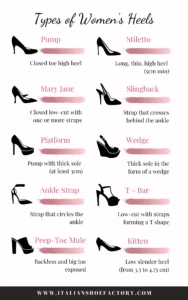Introduction to Different Types of Heels
Heels have been a staple in footwear for centuries, offering both style and functionality. Understanding the various types of heels can help you make informed choices that align with your fashion needs and comfort preferences. From classic stilettos to versatile block heels, each type has its unique characteristics and applications. This guide aims to provide a comprehensive overview of the different types of heels, their history, and their impact on modern fashion.
Classic Stilettos: The Iconic Heel
Stilettos are perhaps the most iconic type of heel, known for their long, thin heel that can range from 2.5 inches to over 8 inches. The design of stilettos dates back to the 1950s, with some sources attributing their invention to Roger Vivier, a renowned French shoe designer. Stilettos are often associated with elegance and sophistication, making them a popular choice for formal events and evening wear. However, their high heel height can pose challenges in terms of comfort and stability. According to a study by the American Podiatric Medical Association, prolonged wearing of high heels, such as stilettos, can lead to various foot problems, including bunions and hammertoes.

Block Heels: The Versatile Option
Block heels offer a more stable and comfortable alternative to stilettos, with a thicker heel that provides better support. This type of heel gained popularity in the 1970s and has since become a versatile option for various occasions. Block heels are available in different heights, ranging from 2 inches to 4 inches, making them suitable for both casual and formal wear. The increased surface area of the heel reduces pressure on the foot, which can help prevent discomfort and injuries. According to a survey conducted by the British Chiropractic Association, 60% of women prefer block heels over stilettos for their comfort and stability.

Kitten Heels: The Moderate Choice
Kitten heels are characterized by their short, slender heel, typically ranging from 1.5 inches to 2 inches in height. This type of heel became popular in the 1950s and 1960s, particularly among younger women who were not yet ready for the height of stilettos. Kitten heels offer a balance between style and comfort, making them a practical choice for everyday wear. They are often seen as a more conservative option compared to higher heels, and they provide better stability and support. According to a study published in the Journal of Foot and Ankle Research, kitten heels are less likely to cause foot pain and injuries compared to higher heels.

Wedge Heels: The All-in-One Solution
Wedge heels are unique in that the heel extends from the back of the shoe to the front, providing support for the entire foot. This design offers excellent stability and comfort, making wedge heels a popular choice for both casual and formal occasions. Wedge heels come in various heights and styles, from low-heeled sandals to high-heeled pumps. The all-in-one design of wedge heels reduces the pressure on the ball of the foot, which can help prevent discomfort and injuries. According to a report by the American Academy of Orthopaedic Surgeons, wedge heels are a safer option for those who need to wear heels for extended periods.

Platform Heels: The Elevated Style
Platform heels feature a thick sole at the front of the shoe, which increases the overall height while reducing the pitch of the heel. This design provides better balance and comfort, making platform heels a popular choice for those who want to achieve a taller look without compromising on stability. Platform heels come in various styles, from casual sandals to elegant pumps. The thick sole of platform heels distributes the weight more evenly across the foot, which can help prevent discomfort and injuries. According to a study by the University of California, platform heels are less likely to cause foot pain compared to traditional high heels.

Conclusion
In conclusion, the different types of heels offer a variety of options to suit different fashion needs and comfort preferences. Whether you prefer the elegance of stilettos, the versatility of block heels, the moderate height of kitten heels, the stability of wedge heels, or the elevated style of platform heels, there is a heel type for everyone. By understanding the characteristics and benefits of each type, you can make informed choices that enhance your style while ensuring comfort and safety.
